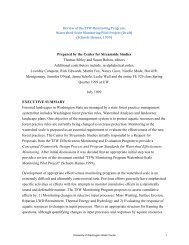Copyright 2012 Aileen M. Echiverri-Cohen - University of Washington
Copyright 2012 Aileen M. Echiverri-Cohen - University of Washington
Copyright 2012 Aileen M. Echiverri-Cohen - University of Washington
Create successful ePaper yourself
Turn your PDF publications into a flip-book with our unique Google optimized e-Paper software.
shown to modify attentional processes (Nakatani, Baijal, & van Leeuwen, 2009). This<br />
explanation cannot be ruled out without a control or waitlist group as part <strong>of</strong> the study design.<br />
Better inhibitory functioning on PPI was associated with better treatment response,<br />
suggesting that better prepulse inhibition may be a potential biomarker for treatment response.<br />
The size <strong>of</strong> the effects here were large but the findings were at a trend level probably due to<br />
sample size. Indeed, identifying biomarkers are a promising approach to understanding disorders<br />
and treatment response (Deutsch et al., 2009; Ritsner & Gottesman, 2009; Van Lieshout &<br />
Szatmari, 2009). Biomarkers are measureable indicators <strong>of</strong> a biological process that is directly<br />
linked to the clinical manifestation <strong>of</strong> a disorder (Beauchaine; 2009; Ritsner et al., 2009).<br />
According to this definition, for PPI to qualify as a biomarker, measurable deficits in this tasks<br />
must be linked to an identifiable abnormal neural network and associated with the<br />
pathophysiology <strong>of</strong> PTSD.<br />
The present study examined inhibitory failures in basic processes <strong>of</strong> sensory gating<br />
processes (Graham, 1975; 1979; Filion, Dawson, & Schell, 1998; Fendt, Li, Yeomans, 2001) that<br />
purportedly result from disruptions in the fear circuitry in PTSD (Kolb, 1987; Morgan, Grillon,<br />
Lubin & Southwick, 1997). Thus, inhibitory deficits measured by PPI presume a common<br />
biological basis <strong>of</strong> a disrupted neural circuitry involving the prefrontal regions and amygdala<br />
(Campeau and Davis, 1995; Hitchcock and David, 1996; Fendt et al., 2001). Abnormalities in<br />
PPI show close associations to PTSD symptoms, with abnormal PPI, or disturbances in early<br />
sensory flooding, being implicated in PTSD (Grillon et al., 1998; Ornitz et al., 1989). As there<br />
are few studies that have examined biomarkers <strong>of</strong> treatment recovery, the findings are<br />
preliminary and need further replication. Taken together, better PPI may represent a potential<br />
45
















